
by Tomato Wellness | Jun 18, 2023 | Food and Nutrition
This Father’s Day let’s talk about men’s health. One of the most pressing health issues for men is prostate cancer, with more than 1.3 million men diagnosed each year. Use this month as motivation to take preventative steps to reduce your risk of getting prostate cancer, including getting screened at age 50, and following a healthy and balanced lifestyle that includes regular exercise and a diet rich in fruits and vegetables.
Fruits and veggies contain fiber and antioxidants that have been shown to help fight cancer and keep you healthy. One of the most potent antioxidants out there is called lycopene, which is the powerful pigment responsible for giving tomatoes their bright red color. According to several scientific studies, people who consume more tomato products have a reduced risk of developing prostate cancer, likely due to the powerful combination of lycopene, vitamin A, and vitamin C that occurs naturally in tomatoes.
While fresh tomatoes are relatively high in lycopene, the compound becomes more bioavailable as tomatoes are cooked, meaning your body can absorb more and take advantage of its anti-cancer properties. Why is this? Heat changes the structure of the lycopene molecule, making it easier for the body to take in, and helps break down cell walls, which frees lycopene and allows it to be absorbed. A recent study found that men who ate cooked tomatoes five to six times per week had a 28% decreased risk of developing prostate cancer versus those who didn’t. Eating tomato products such as tomato sauce, tomato juice, tomato soup, canned tomatoes, tomato paste, and salsa is a great way to ensure you are getting in plenty of cancer-fighting lycopene.
How exactly does lycopene exert its cancer-fighting powers? Scientists have proposed several possible methods, including stopping the growth of cancerous cells in the prostate, controlling proteins that suppress tumors, and preventing damage to DNA that can have lasting impacts on the body. While lycopene is powerful on its own, tomatoes contain other anti-carcinogenic compounds, like vitamin A, vitamin C, and fiber. That’s why you’re better off getting lycopene from dietary sources like tomatoes, rather than from a supplement.

In addition to cooking, adding a little bit of oil to your tomatoes can boost your ability to absorb lycopene even more. This is because lycopene is a fat-soluble compound, and the fat in oil helps lycopene get broken down to a form usable by the body. A serving of whole wheat pasta with tomato sauce and a side salad with olive oil and vinegar is the perfect prostate-cancer-preventing meal!
It’s so important for men to be aware of the most common conditions that can threaten health, both in Movember and beyond. Prostate cancer is a frightening possibility, but early detection and prevention is key in reducing your risk. Along with screenings and a healthy diet and exercise plan, incorporating cooked tomato products into your meals several times a week is an excellent way to make sure you are maximizing your dose of cancer-fighting lycopene.

Get your SWAG!
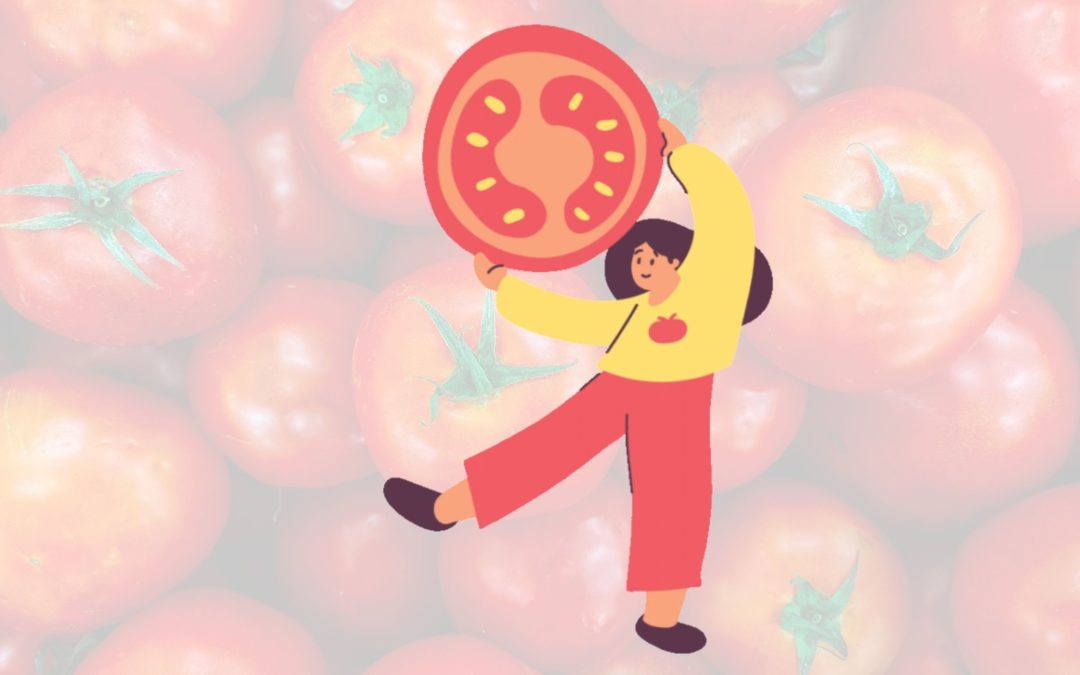
by Tomato Wellness | Jul 15, 2022 | Food and Nutrition
Tomatoes (and their canned varieties) are one of the most versatile produce items available, and while they are beloved by many, there may be some things that you didn’t know about them. From their origin to classification, here are some fun facts about tomatoes.
5 fun facts about tomatoes
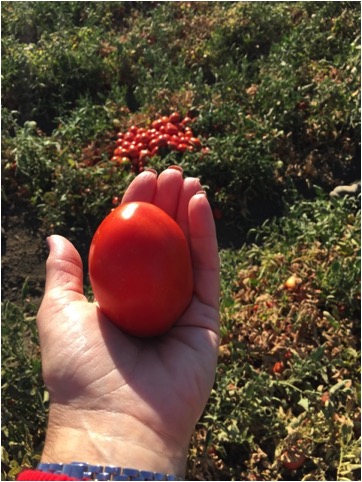
Tomatoes originated in South America.
Researchers have recently discovered a tomato plant that originated 80,000 years ago. By using genetic testing, they were able to trace it back to Ecuador and determined it was a wild variety that produced a cherry sized fruit. Around 7,000 years ago the plant was domesticated and it evolved into the tomatoes we are familiar with today (1).
Tomatoes are technically a fruit.
While nobody would ever claim that tomatoes are as sweet a melon or berry, botanically they are classified as a fruit. Tomatoes contain seeds which puts them in the fruit category, along with cucumbers, peppers, squash, and many more. However, to make things more confusing, in 1893 the US Supreme Court ruled that they are in fact a vegetable (2).

There are more than 10,000 varieties of tomatoes.
Beyond the various sizes (grape, cherry, plum, and beefsteak), there are many different varieties that are grown in a wide range of conditions. Heirloom tomatoes have been around for a long time and are considered pure (ie. no crossbreeding). Others have been crossbred to grow in small spaces or regions that have shorter growing seasons (3).
Tomatoes aren’t always red.
With so many varieties, it should come as no surprise that there would be different colors of tomatoes. They can be yellow, purple, green, orange, or white. In fact, some of the first tomatoes to arrive in Europe were a yellow variety that were referred to as golden apples (3).
Tomatoes have been to space.
Scientists sent tomato seeds to the International Space Station to grow in the Advanced Plant Habitat. They wanted to determine if they could grow and thrive for longer space missions. Along with this study, NASA scientists created a program where students can grow seeds that have been to space and report their findings back to the researchers (4).
Can’t get enough of tomatoes? Check out some of these recipes:
Walnut and Mushroom Ragu
Sausage Tortellini Soup
Huevos Rancheros
Greek Style Braised Eggplant
References:
- The history of tomatoes: How a tropical became a global crop. University of Illinois Extension. (2022). Retrieved from https://extension.illinois.edu/blogs/garden-scoop/2020-07-25-history-tomatoes-how-tropical-became-global-crop.
- Is a Tomato a Fruit or a Vegetable?. The Spruce Eats. (2022). Retrieved from https://www.thespruceeats.com/tomato-vegetable-or-fruit-1807061.
- Vegetable Tomato Varieties. GardenersNet.Com. Retrieved from https://www.gardenersnet.com/vegetable/tomatovarieties.htm.
- Astronauts might soon grow SPACE tomatoes. Phys.org. Retrieved from https://phys.org/news/2019-04-astronauts-space-tomatoes.html.
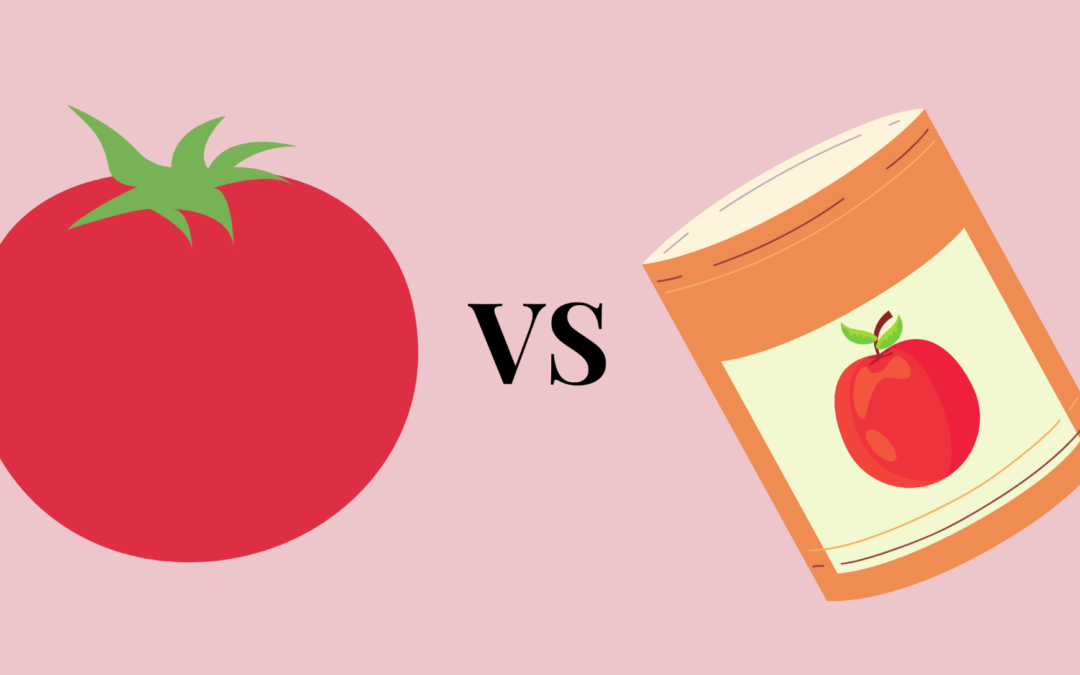
by Tomato Wellness | Jun 1, 2022 | Food and Nutrition, News
Is fresh really best? Despite some common misconceptions, canned goods (like tomatoes) can be a more delicious, nutritious, and a more affordable option compared to their fresh counterparts. Here’s why you should consider adding some canned (or jarred) tomatoes to your grocery list.
Many people may be under the belief that while canned foods are convenient, they are lacking in nutrients. But is this thought process really true? Let’s break down the difference between fresh and canned tomatoes to see which one comes out on top.
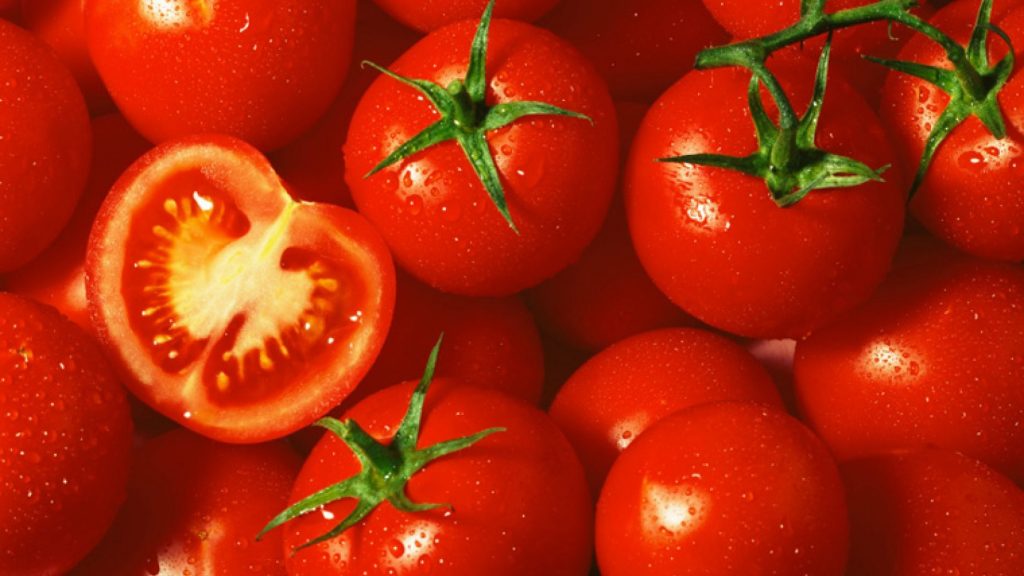
Fresh Tomatoes
Tomatoes pack many beneficial health compounds–such as fiber and vitamins A and C–that are important for a healthy heart, as well as eyes, skin, and gums. Tomatoes also contain a powerful antioxidant and pigment called lycopene, which lends tomatoes their bright red color and contributes to heart health and cancer prevention.
While they may be available year-round, fresh tomatoes are often shipped over long distances in the winter or grown in heated greenhouses. It can take up to two weeks from field to fork to get fresh tomatoes when they are out of season, and they certainly won’t taste as good. While fresh tomatoes can add a flavorful bite to many dishes, they are best when they are in season. However, if you don’t have a garden and have to purchase fresh tomatoes, you might want to reserve them for dishes in which this texture really makes a difference (such as salads and sandwiches), as there’s no need to use fresh in dishes that feature cooked tomatoes.
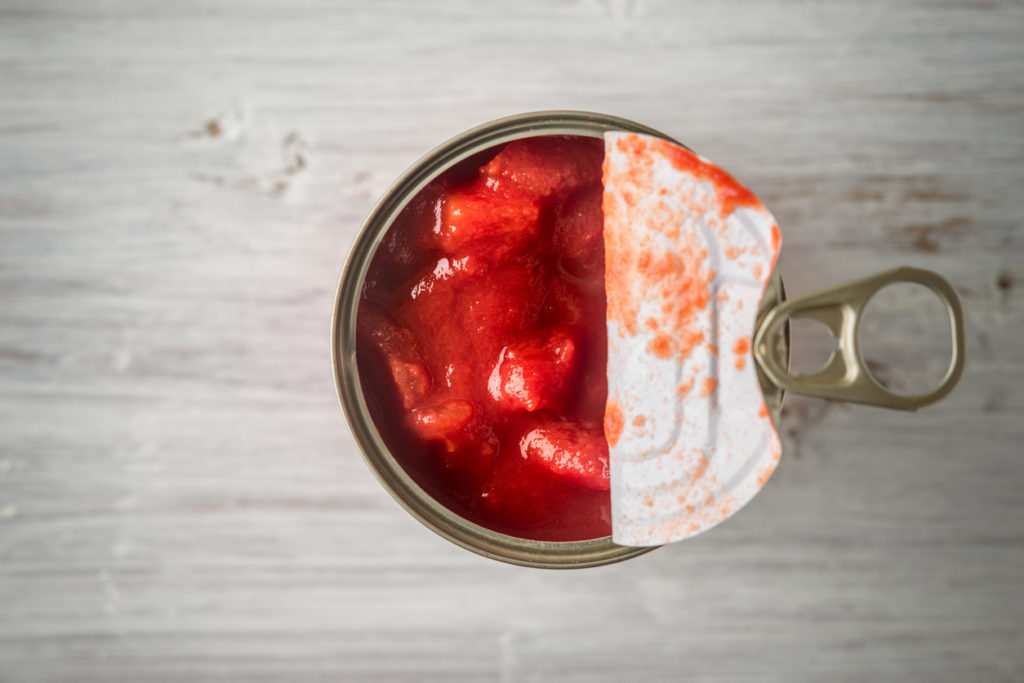
Canned Tomatoes
Canned tomatoes are harvested at their flavor and nutrition peak and canned within just a few hours. Plus, they are quite affordable, meaning that this is a budget-friendly, easy, and convenient option for you and your family.
In addition to the affordability of canned tomatoes, they are rich in vitamins and minerals your body needs to function properly and can help boost energy and reduce the risk of certain diseases. In fact, studies have shown that canned tomatoes are even more nutrient-rich and environmentally-friendly than fresh tomatoes. And, as people continue to cook from the comfort of their own homes, canned tomatoes have grown in popularity thanks to their ease of use, high nutrition content, and a variety of forms (like tomato sauce, tomato paste, marinara sauce, salsa, and diced, stewed and whole tomatoes). Since fresh tomatoes can cost more–especially during the fall/winter/spring–you’re better off using canned/jarred tomato products for dishes in which the texture of fresh isn’t important, such as pasta dishes, pizza, lasagnas, curry, soups, stews, and casseroles and you want that PEAK of season flavor and nutrition.
What’s the verdict?
While fresh tomatoes can be eaten throughout the year, they are at their peak during summer; as such, it can be challenging to enjoy their ripeness during fall, winter, and spring. Conversely, canned tomatoes can be enjoyed all year round as an affordable, nutritious option that consistently delivers those delicious summer flavors whenever you need them.
Use this guide from Sharon Palmer, MSFS, RDN to help determine when it’s the right time to use canned or fresh tomatoes.
| |
Fresh |
Canned |
| Cost |
1.98 per pound, on vine organic* |
.98 per 14.4oz can diced tomatoes** |
| Local Seasonality (U.S.) |
Summer |
Harvesting during the summer; available year-round |
| Flavor |
Firm, plump, juicy, mild. Changes from one tomato to another. |
Consistency! Higher concentration of flavor similar or sometimes better than fresh tomatoes based on the variety of tomato used and processing procedures |
| Cooking Suitability |
SaladsSandwiches
Salsas
Roasted
Grilled
Baked
Kebabs
Bruschetta
|
SoupsPastas
Salsas
Pizzas
Baked pasta dishes
Marinades
Chili
Curries
Stews
Pizza
Casseroles |
| Convenience |
Wash, slice, and dice as needed |
Open can and mix into dishes |
| *Based on price data, May 25, 2017, Walmart.com**Based on price data for Hunt’s, May 24, 2017, Walmart.com |
Learn more about why dietitians loved canned tomatoes with these articles:
Why Dietitians Won’t Bash Canned Tomatoes
Tomatoes: Fresh vs. Canned

by Tomato Wellness | Aug 10, 2021 | News
With all the oxidative stressors present in the environment, it can be easy to worry about our health. Did you know that tomatoes contain properties which protect us against DNA damage and aging? Read more to find out how!
Your body is constantly exposed to oxidative stress. Anything from smoking, drinking alcohol, excessively exercising, or spending time in the sun can produce reactive oxygen species (ROS) which lead to oxidative stress in our bodies [1]. Throughout a normal day, your body can be exposed to many oxidative stressors, which can cause damage to your DNA and speed up the aging process. Things as common as spending time in UV rays or exercising excessively can harm your body on a cellular level. However, there is no need to panic, as eating a healthy diet can protect against the damage caused by these stressors. Foods such as fruits and vegetables contain compounds called antioxidants that can repair the damage caused by oxidative stressors. One of the foods that is the best at doing this job are tomatoes!
So, how can tomatoes protect us against DNA damage and aging? In this study, 10 healthy people drank tomato juice every day for 3 weeks in order to test its effects on reducing oxidative stress. The study found that regular consumption of tomato juice lowered the levels of two markers of oxidative stress in the body [1]. The reason for this is because of the lycopene and beta-carotene in the tomato juice.
The results of this study look promising, but does this mean that you must drink tomato juice every day in order to protect yourself? The good news is that you can take advantage of the health benefits of tomatoes no matter what form they are in! So, enjoy your daily serving of tomatoes in the form of juice, sauce, salsa, or whatever your heart desires to protect against DNA damage and aging!
1.Nakamura, A., Itaki, C., Saito, A., Yonezawa, T., Aizawa, K., Hirai, A., Suganuma, H., Miura, T., Mariya, Y., & Haghdoost, S. (2017). Possible benefits of tomato juice consumption: A pilot study on irradiated human lymphocytes from healthy donors. Nutrition Journal, 16(1). https://doi.org/10.1186/s12937-017-0248-3

by Tomato Wellness | Jul 1, 2021 | Food and Nutrition, Media Recipe
Regardless of the season, everyone is searching for new recipes that can be enjoyed and shared with friends and family. That’s why you should definitely check out this recipe for Wrangler’s Beef Chili! Whether it’s cooked in a slow cooker, stove top, or crockpot, you can never go wrong with a flavor-packed chili dish. This recipe calls for ground beef, veggies, tomato sauce, and macaroni. All of these ingredients provide specific nutrients that make this meal not only full of flavor, but also a secretly healthy comfort meal. For additional flavor, you can top this chili dish off with some crushed baked tortilla chips, green or regular onions, tomato, bell pepper, fresh cilantro, reduced-fat shredded Cheddar cheese, and non-fat Greek yogurt. This dish can be mixed in with baked potato halves or whole wheat macaroni if you are looking for some substitutions. Another interesting component of this recipe is that you can style it two ways: Cincinnati or Moroccan style, by adding alternative seasonings and grains that are specific to this dish.
While this dish is a good source of protein, it also has a high lycopene content from the canned tomato sauce. Since canned tomatoes are a critical part of any chili dish, it’s important to not skip this ingredient. It makes the chili juicy, adds more flavor, and contributes a boost of nutrient-rich value, as they contain vitamins C, vitamin E, fiber, and potassium. The ability of canned tomatoes to absorb more nutrients within the body allow them to contain cancer-fighting properties. Canned tomatoes are easy to find at any local grocery store and are cost-efficient, making them easily available and accessible to the general public. So if you’re trying to stock up on low-calorie, nutrient-rich canned items, then canned tomatoes will be your new best friend!
Get the full recipe for Wrangler’s Beef Chili by visiting our friends at the National Beef Council.












Recent Comments